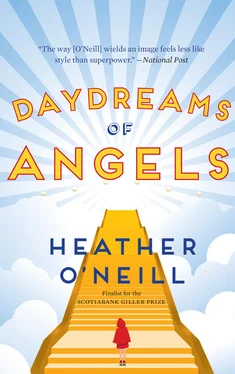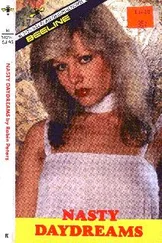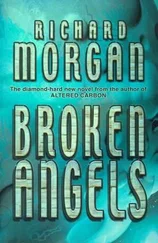At the dump, there were seagulls circling above and crying out as though in pain. The tiny robot, lying on his back, wished that one of the birds would swoop down and pick him up in its claws, because he wanted so badly to be held; but the seagulls seemed interested in everything in the dump except him.
As it started to get dark, the little robot began to feel more and more alone. He stood up on his feet, which looked like tiny salad forks, and stumbled over the garbage. He passed a used shoe, piles of books and tin cans, and green metal chairs and couches with cushions covered in coffee stains. Then, among all of it, he saw something that comforted him: a toaster, lying all by itself. The robot hurried over and wrapped his arms around it, circling its electrical cord around his body. He lay there, entwined with the toaster, and in this way, he tried to assure himself that, somehow, he was loved.
When the stars came out, so numerous and fantastic, the little robot was so struck by the utter mystery of being alone that he forgot, at least for those moments, how painful it was.
As he gazed up at the stars, he was struck by quizzical thoughts, thoughts that, could he articulate them, might take the form of such words as Why am I here? How big is the universe? Why am I me and not someone else?
Although androids all over the world were coming up with an infinite complexity of answers, the little robot was the first to ask a question.
There was once a boy and a girl who were twins. They lived in Montreal. Their mother was a famous cellist. She composed a tune so complex that no one could play it except for her. Their father was a famous physician. He had invented several unsuccessful treatments for polio. But unsuccessful treatments were all the rage back then.
They were serious children, as the children of eminent people so often are. They practised sitting utterly still, in case they ever needed to have their portrait painted. They were able to walk all the way to the park with ten library books on their heads. They were able to use big words that they themselves didn’t know the meaning of. When they sat down to eat, there would be eighteen different forks and they used each one correctly. At ten years old, they worried about death. They never made small talk.
The twins both did very well in their classes at school, and their jackets were covered with little pins for punctuality and attendance, as though they were war heroes. If the children weren’t geniuses, then at least they comported themselves as if they were.
In addition to their reserved disposition, the twins were known for their beauty. They had black hair and pale skin, which had the effect of making them both look uncannily like Snow White. People who manufactured cracker boxes were always trying to get them to pose for them.
One day in 1913, the twins’ parents were invited to attend the World’s Fair. Their parents made the children pack their very best clothes and they boarded the Stromberg ocean liner on the dock in Old Montreal on a cloudless afternoon. The circular windows were in a long row on the side of the ship as though a child had tried to multiply a million times two on a blank sheet of paper.
It was a famous ocean liner. Back then ocean liners were like movie stars. No one ever thought that this particular ship would sink, because so many famous things had happened aboard it. A Bulgarian prince had committed adultery in one of the cabins with a young girl. A French philosopher had composed a text so difficult that no one had even been able to get through the title.
The shipwreck made headlines all over the world. It turned out that the lifeboats had holes in them from termites and they simply sank. Down went all the tea sets and half-written novels and brand new suits to a watery grave. It was a terrible tragedy.
It was reported that there were no survivors. The twins, however, were saved from the wreckage by climbing onto their mother’s cello. The cello made such a mournful noise as it rode over the waves that a whale fell in love with it.
After three long days at sea, they were washed up onto the shore of a deserted island.
For the first night all the twins could do was sit on the beach and feel homesick. They missed going to the zoo. They missed a cat named Clyde. They missed their mother and father. They even missed their classmates and going to school.
The twins had been taught to never sulk and to always be industrious. The next day they began collecting oysters. They opened each one up and peeked inside. By the end of the day their pockets were filled with pearls. They strung the pearls into a long necklace that resembled a diagram of the moon’s phases. They traded it with a pelican for some fish to eat.
The next morning an old turtle stopped by the island. He was brilliant because he was two hundred years old, and he was able to give the twins lessons in philosophy and morality. He came by every morning and in that way, the twins didn’t fall behind on any of their schooling.
Sometimes sea creatures tried to seduce the little girl. She was much too dignified to encourage any of them. The octopus would sneak up onto the beach and place his tentacles around her neck. It felt like she was being kissed by twenty lips at once. It made her feel so strange that she blushed and told him to please return to the bottom of the sea.
The clamshells opened and closed like the eyes of an ingenue blinking slowly at them. As if they were flirting with the children.
Sometimes swans would show up, having heard from birds that the girl was unbearably lovely. The swans were used to being the prettiest creatures on the sea and they, therefore, would go out of their way to the island in order to convince themselves that she wasn’t all that. The girl fell in love with a terribly handsome male swan, but he mocked her affections when she confessed them. With its little Zorro mask, the swan turned his head up to the sky and laughed, which sounded like a bicycle horn being squeezed. She wept at his insensitive response.
The girl wondered if they spent their whole lives on the island, whether she would have to marry a walrus. They were respectable and dependable. They wouldn’t cheat on you. But it would be a loveless life. Some of the swans told her that it took seven years to learn to love a walrus. After that, though, everything was okay. More or less.
The twins saw so many sunrises and sunsets. They watched them as if they were at the theatre. Sometimes they found them so silly that they wept. Sometimes they found them so sad and powerful that they wept too. The sky dressed itself up in a new, fabulous outfit each night before heading off to a nightclub.
One day a current passed by that was filled with the tea that had fallen off a cargo ship en route from Sri Lanka. The twins dipped their teacups into the water and had a tea party. They stayed up all night, alert from the caffeine.
They cast a net in the water that night and pulled in a load of starfish and empty bottles. Lazy pirates, who had no consideration for polluting the sea, would finish their bottles of Coca-Cola and beer and then toss the bottles overboard.
The girl sat by moonlight and wrote letters on the backs of musical scores that were inside the cello case, in order to stick them inside the bottles. She began filling the bottles with letters every night and then tossing them into the sea to be found.
She would sometimes write descriptions of their adventures. She wrote down observations they had made about marine life, and facts about never-before-seen creatures. She also included long descriptions of loneliness and isolation, knowing that these would be valued by the new science of psychology. Like every writer, she felt absolutely sure that her readers were out there. Every night she implored them not to forget about her brother and her on the island.
Читать дальше












